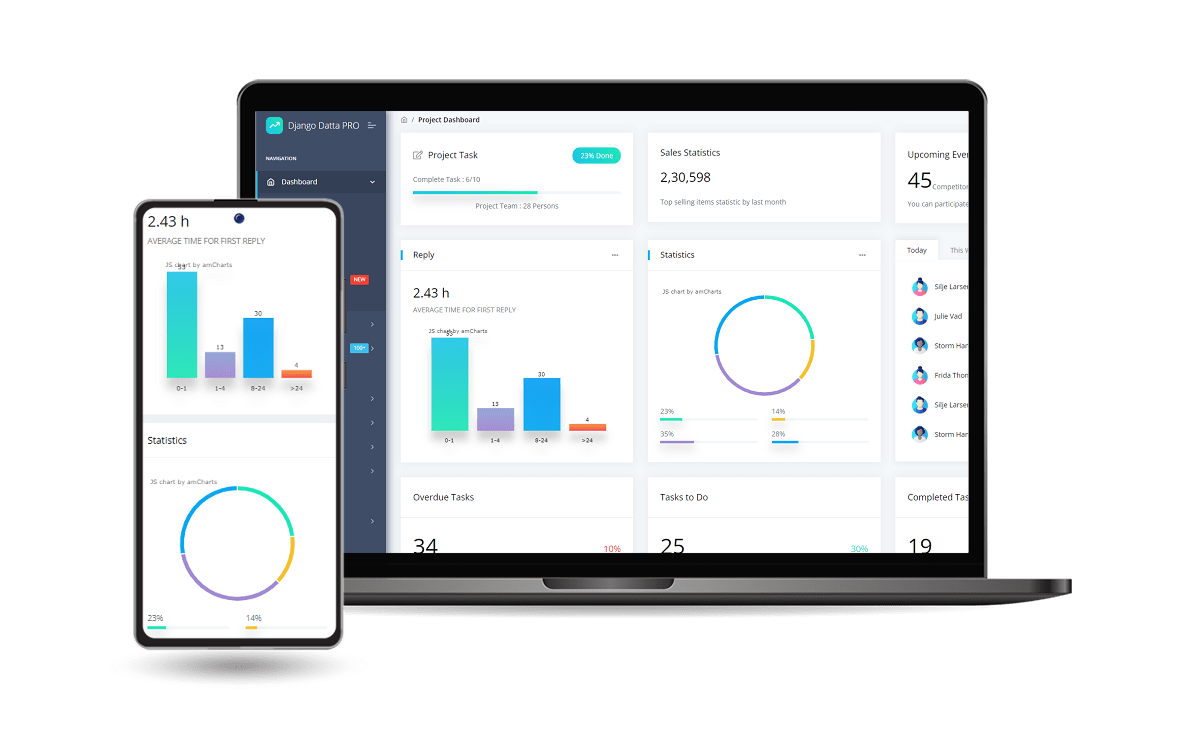Django starter styled with Datta Able Dashboard PRO, a premium Bootstrap 5 design from CodedThemes.
The product is designed to deliver the best possible user experience with highly customizable feature-rich pages.
👉 NOTE: This product
requires a Licensein order to access the theme:
Private REPO: git+https://github.com/app-generator/priv-django-admin-datta-pro
- UI Kit: Datta Able PRO
v1.0.2by CodedThemes - Django Able PRO -
Productthat uses the libraryFeatures: Fully-configured,CI/CDvia Render
- Sections Covered:
Admin Section, reserved forsuperusersAll pagesmanaged byDjango.contrib.AUTHRegistrationpageMisc pages: colors, icons, typography, blank-page
- Modern Bootstrap 5 Design
Responsive InterfaceMinimal TemplateoverridingEasy integration
Datta Able Dashboard comes with error/bug-free, well structured codebase that renders nicely in all major browsers and devices.
Install the package via
PIP
$ pip install git+https://github.com/app-generator/priv-django-admin-datta-pro.gitAdd
admin_datta_proapplication to theINSTALLED_APPSsetting of your Django projectsettings.pyfile (note it should be beforedjango.contrib.admin):
INSTALLED_APPS = (
...
'admin_datta_pro.apps.AdminDattaProConfig',
'django.contrib.admin',
)Add
LOGIN_REDIRECT_URLandEMAIL_BACKENDof your Django projectsettings.pyfile:
LOGIN_REDIRECT_URL = '/'
# EMAIL_BACKEND = 'django.core.mail.backends.smtp.EmailBackend'
EMAIL_BACKEND = 'django.core.mail.backends.console.EmailBackend'Add
admin_datta_prourls in your Django Projecturls.pyfile
from django.urls import path, include
urlpatterns = [
...
path('', include('admin_datta_pro.urls')),
]Collect static if you are in
production environment:
$ python manage.py collectstaticStart the app
$ # Set up the database
$ python manage.py makemigrations
$ python manage.py migrate
$
$ # Create the superuser
$ python manage.py createsuperuser
$
$ # Start the application (development mode)
$ python manage.py runserver # default port 8000Access the admin section in the browser: http://127.0.0.1:8000/
When a template file is loaded in the controller, Django scans all template directories starting from the ones defined by the user, and returns the first match or an error in case the template is not found.
The theme used to style this starter provides the following files:
# This exists in ENV: LIB/admin_datta_pro
< UI_LIBRARY_ROOT >
|
|-- templates/ # Root Templates Folder
| |
| |-- accounts/
| | |-- auth-signin.html # Sign IN Page
| | |-- auth-signup.html # Sign UP Page
| |
| |-- includes/
| | |-- footer.html # Footer component
| | |-- sidebar.html # Sidebar component
| | |-- navigation.html # Navigation Bar
| | |-- scripts.html # Scripts Component
| |
| |-- layouts/
| | |-- base.html # Masterpage
| | |-- base-auth.html # Masterpage for Auth Pages
| |
| |-- pages/
| |-- index.html # INDEX page
| |-- landingpage.html # Sample LP
| |-- *.html # All other pages
|
|-- ************************************************************************When the project requires customization, we need to copy the original file that needs an update (from the virtual environment) and place it in the template folder using the same path.
For instance, if we want to customize the index.html these are the steps:
Step 1: create thetemplatesDIRECTORY inside your appStep 2: configure the project to use this new template directory- Edit
settings.pyTEMPLATES section
- Edit
Step 3: copy theindex.htmlfrom the original location (inside your ENV) and save it to theYOUR_APP/templatesDIR- Source PATH:
<YOUR_ENV>/LIB/admin_datta_pro/templates/pages/index.html - Destination PATH:
YOUR_APP/templates/pages/index.html
- Source PATH:
- Edit the
indexpage (Destination PATH)
At this point, the default version of the index.html shipped in the library is ignored by Django.
In a similar way, all other files and components can be customized easily.
Django Admin Datta PRO - Modern Admin Interface provided by AppSeed
